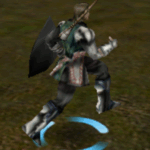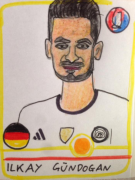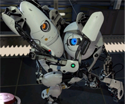|
Hmm, assault the heartland of the enemy and break the back of their greatest power while they're busy throwing troops into a meatgrinder on another continent, or push through a thousand miles of godawful terrain before reaching their industrial regions? Across the Channel!
|
|
|
|

|
| # ? Apr 20, 2024 03:44 |
|
Can we just push through to Constantinople? We'll get that sweet Baku oil and it'll make defending Asia Minor more convenient. Plus we get to liberate another cool state. So: B
|
|
|
|
B
|
|
|
|
A
|
|
|
|
A We just gotta.
|
|
|
|
Crazycryodude posted:A, we can't just invade Britain and then not have a wonderfully climactic D-Day analogue. This is supposed to be a fun side campaign, let's do all the crazy poo poo.
|
|
|
|
Before D-Day, there was Gallipoli.
|
|
|
|
A
|
|
|
|
Crazycryodude posted:A, we can't just invade Britain and then not have a wonderfully climactic D-Day analogue. This is supposed to be a fun side campaign, let's do all the crazy poo poo.
|
|
|
|
A. Let India hold the line for now, the real fight begins on the shores of Normandy.
|
|
|
|
Bloody them, but carefully.
|
|
|
|
D-DAy!
|
|
|
|
Always keep the enemy off balance: 1) Strike across the Channel so they send reinforcements to France. 2) Start the invasion through Turkey. 3) Wait until they draw down the reserves in France, then... 4) D-Day! What's the naval situation in the Mediterranean like? Are we going to have to keep garrisons from Sidi Barrani through Latakia to contain any landings from Italy?
|
|
|
|
Attack! Attack! Attack!
|
|
|
|
Beat them senseless.
|
|
|
|
A Invading through Turkey and the Caucasian Mountains will be slow and will stretch our supply lines. At the same time, the reds will have the entire industrial might of Europe churning out divisions, and their lines will just get shorter and shorter as we advance. We could win, or it could devolve into a bloody stalemate before Russia decides now's the time to swoop in and grab our poo poo.
|
|
|
|
Groly posted:Always keep the enemy off balance: There is a smallish Italian and a medium sized French fleet in the Mediterranean but now that there are bases available, we can split the Japanese-Canadian armada and secure the coast. Algeria being a fucky mess still means no air raids on those fleets yet but there are bases available to be taken (Malta/Corsica/Sardinia) so that is an option.
|
|
|
|
he who dAres, wins
|
|
|
|
A. On the face of it the new front in Anatolia looks like an opportunity, but consider just how narrow it is, and how poor the terrain. How many units will we find dug in behind miles of fortifications in those mountains? In Kars, then Yerevan, then Baku, and on and on. Even in victory our losses would be catastrophic. Then we would have to march enormous distances through awful terrain, quite possibly getting bogged down in winter, with infrastructure that was outmoded in the Tsar's day, and a near-complete lack of airbases for air support. But perhaps more importantly, we have been planning for the attack on Europe for years now. It has guided our technological development, strategic planning, our political choices, our counsel to our allies, our decisions regarding those who proclaim neutrality or friendliness-without-alliance (as few of those as remain), the disposition of our forces, and more. We launched the greatest oceanic invasion in history as a stepping stone to this.What would our navy even do on this course? Our marines? Our fast and mobile units? To change course now would be absolute folly, unless we devoted months if not years to preparing, giving the enemy considerable time to fortify yet further. Perhaps devote some second-rate divisions to ensure the front holds or even to make an opportunistic push on Turkey if the chance arises, but no more.
|
|
|
|
C, do both.
|
|
|
|
|
B sounds way more interesting.
|
|
|
|
Like the ancestors say, Always be amphibiously invading.
|
|
|
|
we are a mAritime people
|
|
|
|
Voting Closed! Option A: The Direct Approach wins it 16-12 (with 1 non-SA vote for B).
|
|
|
|
Chapter Twenty Three: A Line In The Sand (February 26 – April 15, 1942) The Indian Army had been seeking an opportunity to score a great victory as an army of all India. It was hoped that this would be a chance to unify India in spirit beyond the political reunification. The swift defeat of the Arab Bloc was just that opportunity. It had been a great accomplishment in that the operation was carried out with enough speed and daring to prevent most of the Middle East from falling into the hands of the Bukhara Caliphate. The operation had not actually blooded the Indian Army, however. They had executed a grand maneuver with light casualties, yes, but it was against a surprised enemy engaged against another powerful foe. And so when the swaggering Indian cavalry came into contact with the French invaders from Turkey, they were quickly educated in what modern war could actually be.  The Indians found out quickly that the veteran French units had better weaponry and more solid tactics.  Numerical advantage over the advance French units provided a few victories for the Indians.  However much the Indian press displayed photos of captured French soldiers, the Entente command recognized that the French would be a much stouter foe than the Arabs. Rather than allowing the Indian Army to advance with reckless abandon as they had just a few months prior, the Entente positioned infantry in defensive positions.  French cryptography had become very difficult to crack, as the remaining Internationale members revamped all of their cyphers after so many British Republican code machines were captured. It was known that the French were deploying troops across a front from Aleppo to the edge of Caliphate control, but how many divisions was utterly unknown. The Entente needed to wait and see what developed.  It was impossible for the French to mask the mobilization that took place. Details were again difficult to pin down, but a great French army had certainly entered the region.  Their arrival did not inspire panic, as it was followed shortly by the arrival of the Chinese Army.  As the Chinese adjusted to their first large scale overseas deployment, good news arrived for the Entente as the uncooperative National French and South Africans deployed their own forces to the front. They, as expected, refused to integrate into the Entente’s Eastern Command. Their obstinacy had consequences, as they would not participate in the Entente’s plans, but they did take responsibility for defense across certain sectors. No amount of enmity between those two nations and Japan would convince them that it was a good idea to allow potentially several dozen French divisions roll over such a vital region.  This was wise on their part, as the developing front line between the Internationale and Entente just about fell on the boundary line between the great deserts and the mountainous terrain of Anatolia. If the French were able to break through, their motorized elements would move even more rapidly in the rear than the Indian cavalry had.  The first large scale battle between the Indians and the French took place in northern Lebanon. The speed and efficiency of the Internationale logistics network allowed the French to bring their experienced and well-equipped infantry all the way to Syria, while the inexperienced Eastern Command fumbled about as amateur armies speaking different languages had to learn under hostile conditions.  Among the divisions arriving to reinforce the line was JEF Africa, which had seized just about every bit of rolling stock in the Sudan in order to redeploy from Khartoum to Iraq. The Indian commanders present on the front were eager to ask the Japanese, who had fought modern armies such as the French, to take strategic lead.  The Japanese idea of how to help the embattled Indians in Lebanon was a classic Sakai maneuver: rather than responding to the enemy attack, launch an attack on their weak points and throw their offensive off balance.  The Indians in Lebanon were not particularly pleased with this “help” as they continued to be outnumbered by troops that were individually of higher quality than the journeyman soldiers trying to hold the mountains.  The Indians sounded the retreat after taking eleven thousand casualties.  The arrival of the Korean Army in Beirut would help to stem any further advance into Palestine, however. The hope was that the temporary concession of northern Lebanon to the enemy would allow the other forces further inland to flank Aleppo and push the Internationale into Turkey.  The Entente counter-attack found success, unsurprisingly, on the plains west of Baghdad.  The hilly terrain in Syria was a tougher nut to crack. Being closer to the Internationale staging ground near Aleppo, it was also easier to reinforce than Iraq.  More sketchy intelligence came in about the size of the French reinforcements, and even accounting for a wide margin of error scared the attackers to death. More reinforcements would arrive daily, and so the attack was called off.  The French over-estimated how disorganized their enemy was, and attempted to attack Karbala, though the undermanned assault would eventually fail.  They did not fail in their counterattack against the Chinese motorized infantry in El Hillah. The Chinese had outrun their slower and much more numerous comrades still on the march from the south.  The size of French reinforcements made Entente commanders less and less hopeful about the potential of breaking through to the Caucasus and so the Chinese were pulled back so that they could fall in behind establish defensive positions.  Homs was still considered a point of important strategic interest however. Capturing it would effectively shorten the front as well as allow the Entente to threaten Aleppo itself.  The mass assault was called for with all divisions present in southern Syria and western Iraq. The problems were immediately evident. Poor communication among the coalition partners exacerbated the problems of too many divisions trying to use too few roads. All the while they were coming up against determined French defenders already dug into positions throughout the Syrian hills.  Homs would have been nice to have, but the risk of rendering the center of the Entente line too weak to resist a breakthrough attempt could have been disastrous, and so that attack was also called back.   It was time to admit what the situation was. The superior French logistics network had delivered an enormous force to the front in a record amount of time, and the Entente coalition could not hope to overwhelm it without being overly hampered by their own logistics and coordination issues. El Hillah and northern Lebanon were abandoned, and all forces in both areas were pulled back to established defensive positions. It had taken a mere six weeks for the Middle Eastern front to transform from a small-scale battle between the Indian Army and French advance units to a stalemate where over two million men on both sides dug in along a five-hundred-mile front from Beirut to the Tigris. Neither side would be able to prevail in a frontal attack, and neither side was all that willing to attempt it, given the memories of the Great War. One side or the other would have to make a grand strategic maneuver to change the nature of the war altogether, and the Entente was planning just that. STRATEGY VOTE #1: Operation Shogun It has been decided that arriving divisions from North America should be combined with the present divisions in the British Isles to form the Entente Western Command, and that the Western Command should invade France as soon as possible. This goal is seen as plausible to achieve in 1942 given the enormous portion of French forces redeployed to hold back the Eastern Command. Two battle plans have been drafted up, and resources are only available to execute one of them. Either one would be codenamed Operation Shogun. Option A: Cross-Channel Assault 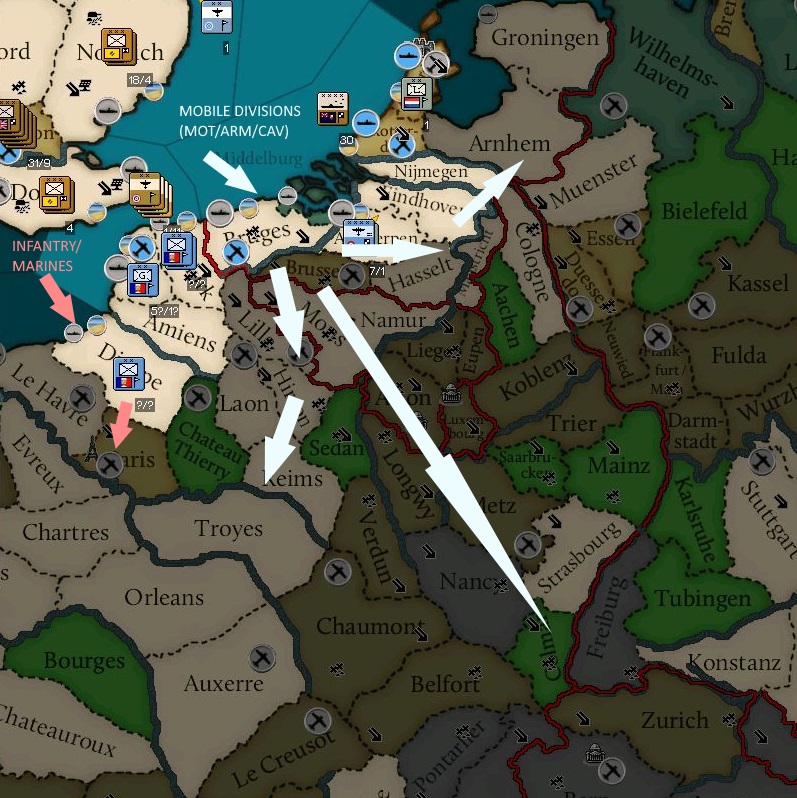 A chink in the armor of the Internationale has been discovered, and it is namely the Netherlands. The Netherlands lost a large portion of its small army in America, and so several suitable landing zones in the Netherlands and Flanders are hardly defended at all. This plan sees the Western Command’s armor, cavalry and motorized divisions being landed in Flanders. The marines would attack Dieppe and attempt to capture Paris while being reinforced by the bulk of Western Command infantry. The goal of this offensive after establishing a beachhead would be to push south towards Alsace-Lorraine and Switzerland, and to divide France from its client states in the east. Criticism of this plan focuses on the idea that it creates too wide a salient in the push to Colmar, as inevitable French redeployments back to the homeland will fall upon the armored spearhead in unfavorable heavily forested terrain in Germany perhaps before the infantry landing in France can seize enough of France. Other criticism is that the largest concentration of French infantry left in the homeland is in Wallonia, and that that infantry could be easily deployed to respond to either landing. Option B: Normandy-Poitou Pincer 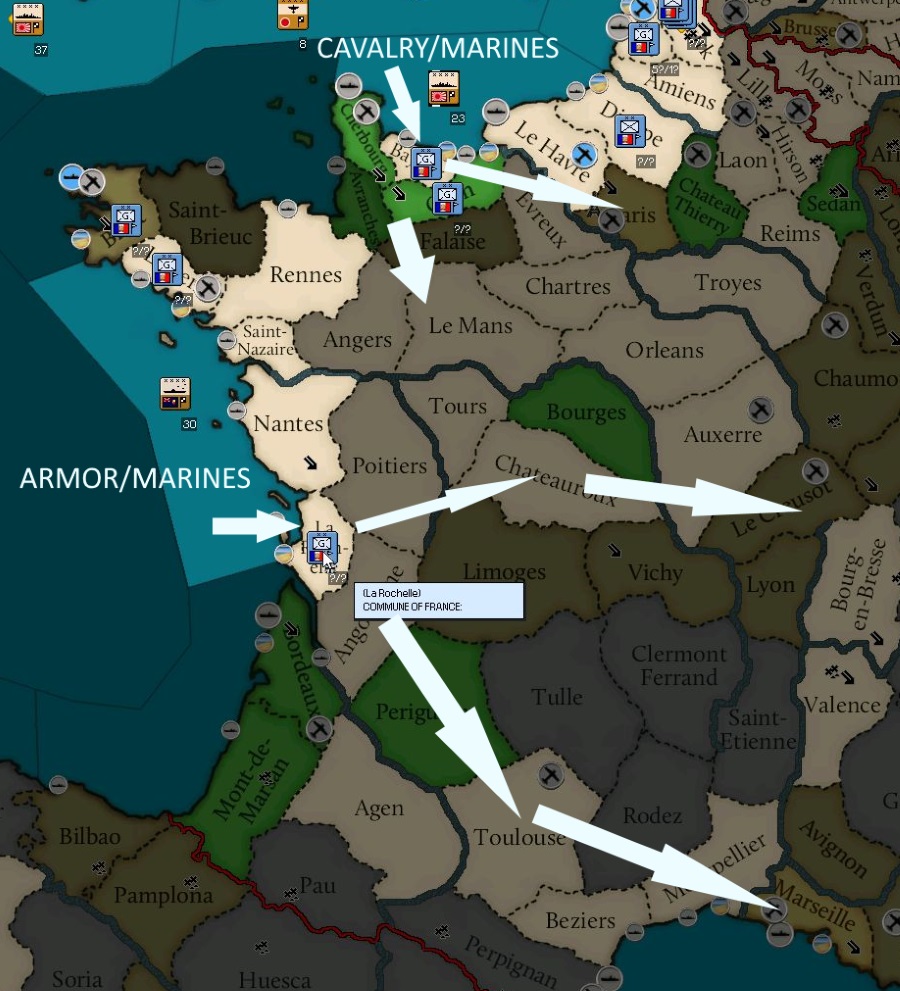 The second plan involves a separation of Western Command into two forces. Force A would have all of the cavalry and land in Normandy. Force B would have all of the armor and motorized divisions and land in La Rochelle. Both forces would be supported by marines and reinforced by infantry. Once ashore, Force A in the north would attempt to seize the industrial centers. Force B would attempt to capture the rest of metropolitan France, especially Marseille, the home port of the French Navy. It would also attempt to reach the border with Italy and prevent the Italian military from establishing strong defenses in the Alps. The goal of this plan is to destroy France’s industrial capability as soon as possible. While France will not surrender until its other territories in the east are also captured, the hope is that cutting off the Internationale from France’s industrial might would weaken all of the other client states as well as the French Army in Syria. Criticism of this plan focuses on the fact that it does not exploit any of the badly defended beaches in the Netherlands, which many planners regard as a rare and precious opportunity. The La Rochelle landing point is farther away and would take more time to reinforce than the cross-channel landing beaches, and the landing beaches are far enough away from one another that it would not be easy for one successful landing force to support the other if they face difficulty. STRATEGY VOTE #2: The Persian Gambit  The potential for Turkestan to attempt to strike at India had always been of great concern, and the King Doctrine was intended to protect the Entente in the region from precisely that threat. However, the Bukhara Caliphate has apparently elected not to strike. 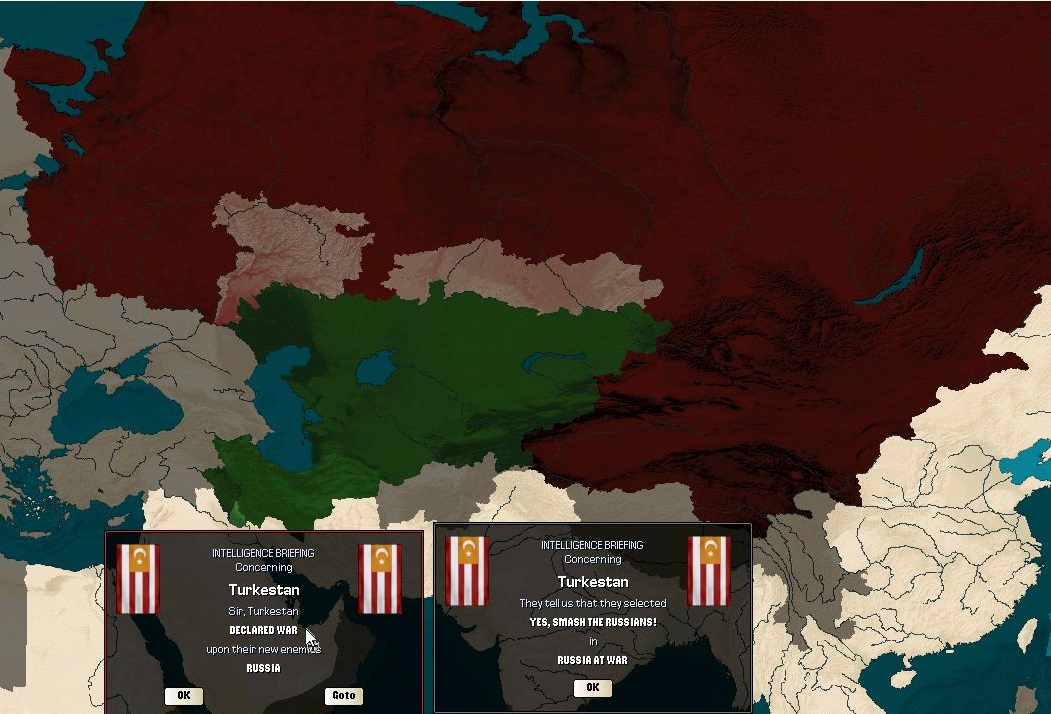 Inexplicably and also in contravention of Entente worries, Turkestan has not found common cause with Russia. Instead they decided to attack. Virtually all observers expect Russia to overwhelm Turkestan with their superior numbers. With this in mind, an idea has come up on how to break the stalemate in the East. 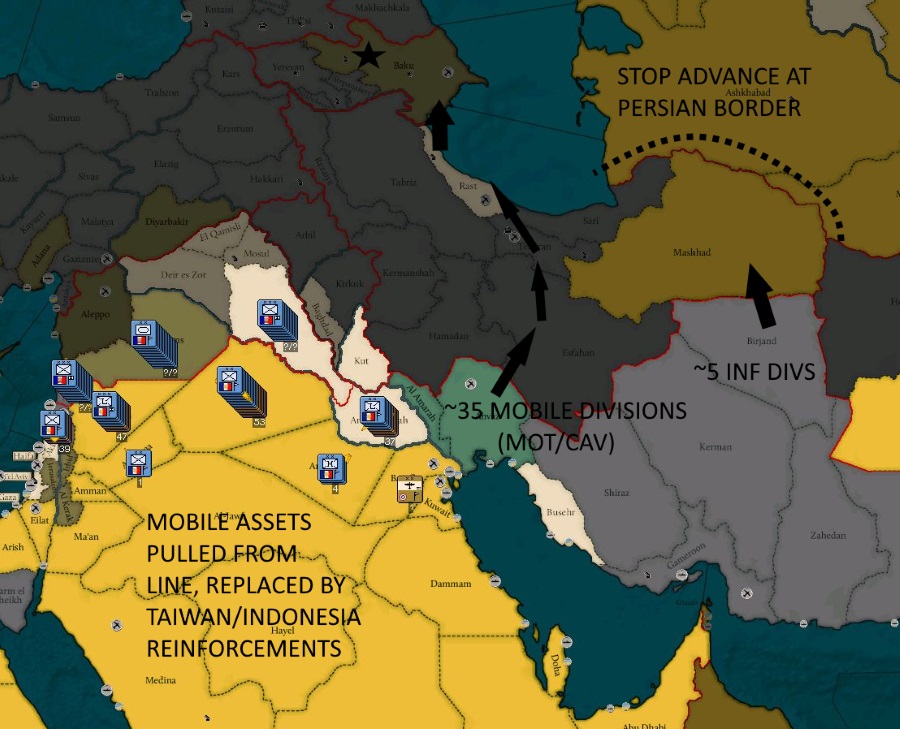 The plan involves pulling 35 mobile divisions (cavalry and motorized divisions) from the line, replacing them with Indonesian and Taiwanese divisions. These 35 divisions would be joined by 5 new infantry divisions from India and China, and after a declaration that Persia must be entirely free, all 40 divisions will cross the border into Persia. The hope is that Turkestan will have deployed all of its combat strength north against their superior Russian foe and that the rump state will be easily overrun. The advance would stop at the Persia-Turkestan border, in order to avoid antagonizing Russia prematurely, and also because the divisions are not available to expand the war into the wide expanse of Central Asia. The reason for this operation is not Persia itself, of course, but rather to use Persia as a back door to attack and seize Azerbaijan, which is the most strategically critical region in the entire war. Baku is not only a great center of oil production, but it is, along with Armenia, the chokepoint which separates the Internationale territories in Turkey and Bulgaria from the main Internationale territories that stretch from France to the Caucasus. Seizing it would prevent the French divisions in the East from redeploying in response to the landings in Western Europe, and instead those divisions would have to either break the Entente’s occupation of the mountainous chokepoint or they would have to be ferried across the Black Sea, which, considering the poor condition of Internationale shipping, would likely take a long time. The concerns about this plan are that the replacements on the line are of lesser combat effectiveness than the divisions diverted to this plan and that the shifts may cause the line to be unable to hold up against a general French offensive. Another concern is that the 40 divisions would be on their own to hold the Caucasus given the need for every other division to remain on the existing lines in Iraq and Syria. Opponents of the plan believe that the landings in Western Europe will inevitably cause divisions to be peeled away to defend the homeland, and that the reduced strength of the French in the Middle East will allow the Entente Eastern Command to launch a successful offensive. Therefore, three options exist: Option A: Do Not Approve the Persian Gambit The attack will not take place, and the Entente Eastern Command will make a frontal attack along the existing front as soon as enough French divisions have been sent back to the homeland. Option B: Approve the Persian Gambit For Before Operation Shogun The attack will take place and Operation Shogun will launch once Azerbaijan is captured, thus preventing any of the French divisions from redeploying back home to defend against Shogun except by sailing to Ukraine. All of the 100+ French Divisions currently in the Middle East would remain and would have to be rooted out in that bad terrain. Option C: Approve the Persian Gambit For After Operation Shogun The attack will take place soon after Operation Shogun once a significant portion of the French Army in Syria has deployed to the homeland. This will then trap the remaining forces. Western Command will likely deal with reinforcements from the Middle East after the landings, but the Eastern Command will be faced with a smaller army than the enormous one currently in their theater.
|
|
|
|
1A 2A
|
|
|
|
B A
|
|
|
|
BB
|
|
|
|
AB
|
|
|
|
1A 2B
|
|
|
|
BC
|
|
|
|
BB
|
|
|
|
AC
|
|
|
|
B C
|
|
|
|
1B 2B
|
|
|
|
1A - with how many troops the French have deployed in Southwest Asia, they haven't a hope of bringing enough back home in time to stop the push along the Rhine... 2B - ...especially if they have no land route home and the navies can blockade the Med.
|
|
|
|
AC
|
|
|
|
BB
|
|
|
|
1B 2B
|
|
|
|

|
| # ? Apr 20, 2024 03:44 |
|
BB
|
|
|









